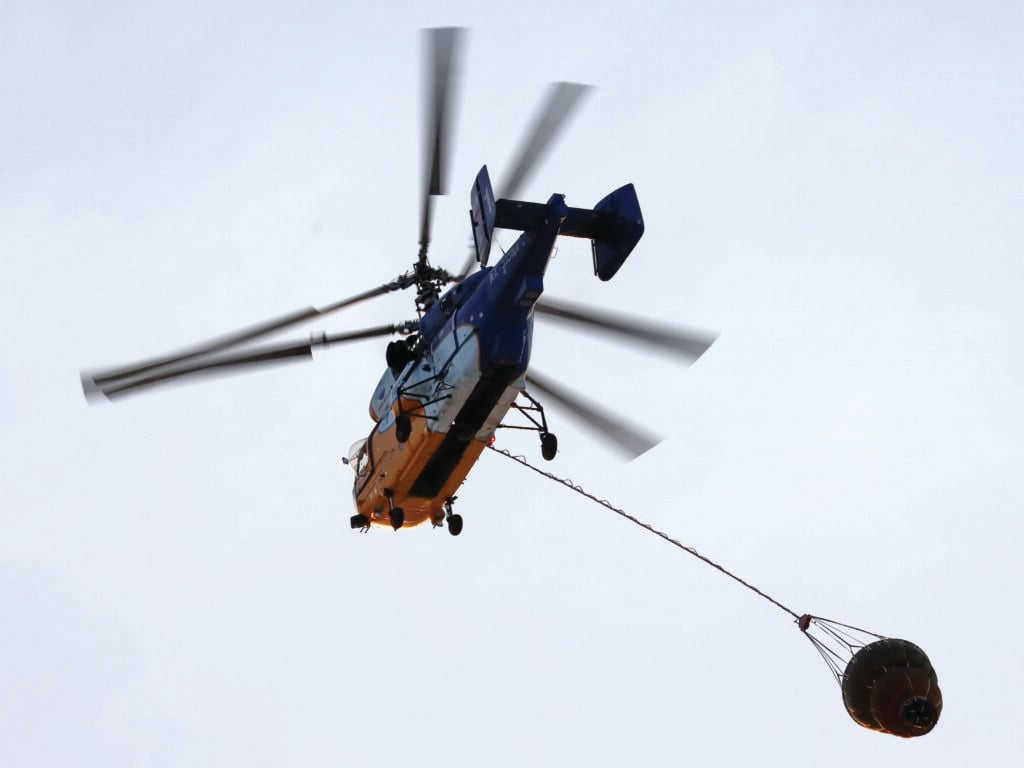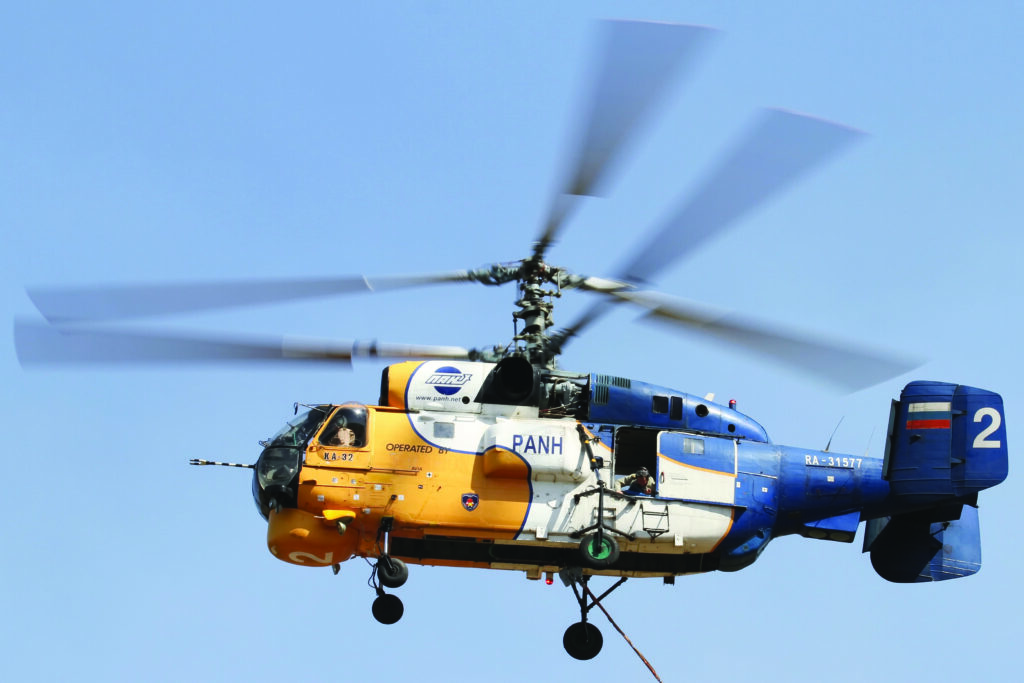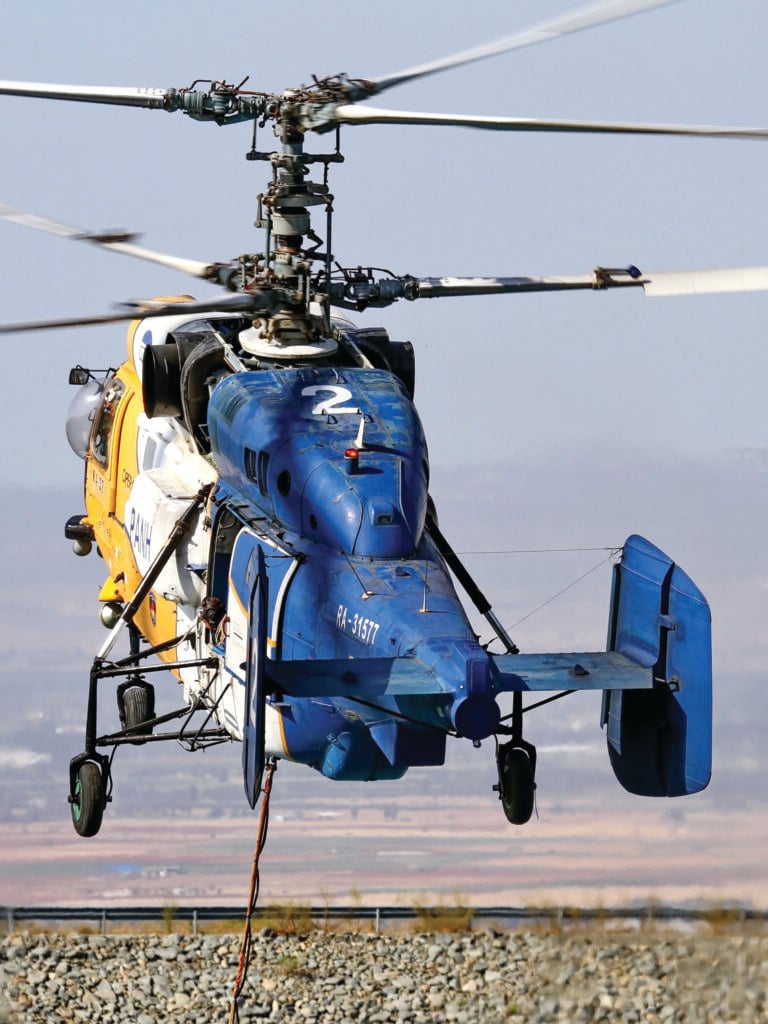By Babak Taghvaee
Every year, Cyprus faces widespread wildfires, which not only require government and military organizations of the country to dedicate their aircraft and helicopters to tackling them but also require foreign assistance. The Royal Air Force, with three helicopters; the Cypriot Police Aviation Unit, with four; and the Cypriot Department of Forestry, with two firefighter aircraft, are the only permanent firefighting air assets on the Island. This has required the Cyprus government to lease several more air assets to deal with fires every year since 2001.
For almost two decades, two to three Kamov Ka-32 helicopters were leased during the summer and fall. From 2001 until 2021, PANH Helicopter Services provided this service with its Ka-32AOs. Still, since 2022, a Swiss-based company, Arctic Group SA, has leased two of its Ka-32Ts to the Cypriot Forestry Department. Based at Paphos International Airport, these helicopters stand alert from dawn until dusk to fight wildfires alongside the air assets permanently based in Cyprus.

About the Ka-32A and its difference from Ka-32T
In 1979, production of Ka-27PL anti-submarine helicopters began at the KumAPP plant in Kumertau, Soviet Union. A year later, the production of a derivative named Ka-27PS dedicated to search and rescue operations began. In November 1979, the high performance of the Ka-27 drew the attention of Aeroflot to use it for Arctic research and explorations. This led to creating a civilian derivative of the Ka-27 named Ka-32. It was manufactured in two types, Ka-32S equipped with radar for SAR operations and Ka-32T without radar for cargo operations. Ka-32's prototype flew for the first time on October 8, 1980. Five years later, it was displayed during the 35th Paris Airshow. Ka-32T (cargo variant) mass production began in the KumAPP plant in 1986. From 1987, some were produced in Ka-32S (SAR) configuration.
Before the collapse of the Soviet Union, JSC NI Kamov designed and developed a special variant of the helicopter named Ka-32A, which was adapted to the requirements of the Transport Category Rotorcraft (FAR Part 29) and Aircraft Engines (FAR Part 33) standards of Federal Aviation Administration (FAA) for the American market. In September 1990, its prototype logged its maiden flight and three years later, it received its certificate. Ka-32A was designed and built for use in North American and European markets. However, its derivatives were also largely sold to various helicopter services companies and government organizations in Russia. These helicopters have played an important role in tackling wildfires worldwide thanks to their capability of carrying four to five tons of water internally or externally.

Nine different derivations of Ka-32As have been developed since 1994. They are the Ka-32A1, Ka-32A2, Ka-32A3, Ka-32A4, Ka-32A7 (Ka-27PV), Ka-32A12, Ka-32A11BC, Ka-32A11M and Ka-32AO. Throughout history 188 Ka-32s have been manufactured that include two prototypes. Among the examples built, two are known to be Ka-32A1, 49 to be Ka-32A11BC, and seven to be Ka-32A4. All of these helicopters were built for civilian use except seven Ka-32A4s, a military modification of Ka-32S civilian SAR helicopters designed and developed for use by the South Korean Air Force (Republic of Korea Air Force). Seven were manufactured, equipped with Israeli-made avionics made by IAI (Israel Aerospace Industries) Lahav in the LG International facility between 2004 and 2006 before being put into ROKAF's service as HH-32As.
Of the seven civil derivatives of Ka-32A, Ka-32A1 was a firefighting modification. Two were built in Moscow City Hall to extinguish fires in high-rise buildings, while Ka-32A2 was a police helicopter developed in Moscow city. A Ka-32A prototype was converted into that which flew for the first time on March 21, 1995. It didn't draw the attention of Police forces. Ka-32A3 was a special modification of Ka-32A for use in SAR, Cargo Transport, and Firefighting operations. Six of these were manufactured for the Ministry of Emergency Situations of the Russian Federation. Ka-32A7 was a special armed modification of Ka-27PS with a powerful engine and advanced avionics of Ka-27. It was built in 1995 utilizing the conversion of a serial produced Ka-27PS. It never found a customer.
In 1996, a Ka-32A was converted to Ka-32A12 to adapt to the requirements of Swiss civil aviation authorities for use by HeliSwiss. Another similar helicopter was built with the name of Ka-32A11BC, which was modified to adapt to the Canadian civil operations standards. The last and most advanced member of the Ka-32A family is Ka-32A11M, based on Ka-32A11BC but with entirely powerful and improved engines, auxiliary power units (APUs), and fully Russian Avionic systems. It was equipped with powerful 1,765kW (2,400hp) VK-2500PS-02 turboshaft engines and TA-14 APU. The first prototype flew for the first time on November 15, 2021. It is planned to have its certification tests finished in 2023.

The last member of the family of Ka-32A helicopters is Ka-32AO. These helicopters, the Ka-32S and Ka-32Ts, were upgraded to Ka-32A standard for use in civil operations. They were modified for cargo and personnel transport, search and rescue, and fire-fighting. They were nicknamed flying cranes. The helicopter received its airworthiness certificate from the Russian Aviation Authority on August 4, 2000. Two Ka-32T helicopters of Russian company PANCh-Avia (also known as PANH Helicopters) with RA-31064 and RA-31579 registration codes and one Ka-32S with RA-31571 registration code were upgraded to Ka-32AO standard by the manufacturer.
PANH also had a 1993 built Ka-32A with RA-31598 register converted to Ka-32AO in 2003. In addition to the Ka-32AOs of PANH, a Ka-32T, and a Ka-27PS were upgraded to similar standards following an order from a Bulgarian company, Scorpion Air, in 2002. They received LZ-MOR and LZ-MRK registration codes.
20 years of Ka-32 operations by PANH in Cyprus
Kamov Ka-32 has been known as the best helicopter for firefighting operations on the Island. Capable of carrying the highest amount of water inside the cabin or in a bambi bucket under the fuselage with the lowest operational cost compared to other helicopters such as AS332 Super Puma. In 2001, the Cypriot government leased two Ka-32s for fire-fighting operations; in the next year, it increased to three. In August 2001, Cyprus showed its intention to purchase three Ka-32Ms, an improved helicopter variant under development. Its lifting capability was up to 7,000kg thanks to its two TV3-117VMA-SB3s, each producing 1839kW (2,466hp) of power, which was more powerful than Izotov TV3-117VMs of Ka-32, each producing 1,618kW (2,200hp) power each.
Due to budgetary issues, procurement of the helicopters never took place, and as a replacement, leasing of the helicopters from PANH Helicopters Company continued until 2021. Due to the necessity of firefighting operations in hot environments and mountainous regions of the island, especially Troodos mountain, PANH always had its small fleet of Ka-32AOs on deployment at the Island, which was allowed to airlift a maximum of five tons of water. In case of unavailability of all three Ka-32AOs, the company sometimes had one or two of its Ka-32S or Ka-32T helicopters deployed to the Island as a backup for two Ka-32AOs.

According to PANH, Ka-32AO was initially intended mainly for people transport (15 seats in the cargo cabin) and search and rescue duties. Still, it was mainly used as a cargo helicopter capable of carrying large-sized freight on an external sling weighing up to five tons. To increase the maximum take-off weight and also the weight of the cargo airlifted by the helicopter, the helicopter lacks some of the equipment found on Ka-32S and Ka-32T, including the Osminog-PS-32 radar and LPG-300 winch over the side cargo door of Ka-32S. In Cyprus, the engine cowling of these helicopters had always been removed as a further effort not just to reduce the weight but to increase the performance of the engines.
Deployment of the helicopters to Cyprus always took place in May. After their arrival, their crew had familiarized flight training before participation in a joint exercise with Cypriot Police Aviation, Cypriot National Guard Air Command, the Flight Unit of Cypriot Forestry Department, and finally, the Royal Air Force, which usually took place in a day in the first or second week of May. Starting in the third week, the helicopters were involved in firefighting operations.
For 20 years, PANH won all the tenders of the Cypriot Forestry Department for leasing its helicopters for use in firefighting operations. The last tender of this kind was held by the Forestry Department in March 2019 for a two-year lease (plus a one-year extension) of two Ka-32s for a maximum cost of EUR 1.600.000 per year (excluding VAT) for their services. As per the tender requirements, the helicopters needed to be operationally available from 11:00 to 18:00 for May, October, and November and from 10:00 to 18:00 for June, July, August, and September, with a total of 20 hours of unscheduled maintenance for each one of the helicopters in this period.
The expensive Artic Kamovs
The Russian invasion of Ukraine led to more restrictive embargoes on the country by the European Union, which led to the Cypriot Forestry Department's inability to renew the PANH contract. Subsequently, the Department, a part of the Cypriot Ministry of Agriculture, issued a new Tender in March 2022, which had No participants as No other helicopter services company in the world could provide similar services to the PANH for a similar price.
To be able to contract PANH helicopters again, the Cypriot Foreign Ministry began negotiations with the European Union in Brussels in the hopes of securing an exemption from EU sanctions against Russia. As the negotiations failed, the Cypriot Ministry of Agriculture increased the value of the tender. Finally, the tender winner became a Swiss-based company named Artic Group SA using several Ukrainian-registered Ka-32T helicopters.
Two Ka-32Ts of the company with UR-CIO and UR-CIS registration codes arrived at Paphos International Airport on July 26, 2022. Starting from August 1, 2022, their operations in Cyprus began. In October 2022, information about details of the contract for leasing the helicopters leaked to the press, which indicated that the value of their contract for a period of three years (2022 to 2025) was EUR 3.2 million per year, almost two times more than the similar service provided by the PANH between 2019 and 2021!
Between August and November 2022, these helicopters logged 68 hours of flight with a total cost of EUR 3,600 per hour. Ka-32s had their missions ended by the end of November 2022, but they once again returned to the Island in early May and logged their first mission for battling a large wildfire west of Larnaca on May 17, 2023.
Due to their age and additional equipment compared to the Ka-32AOs of PANH, the two Ka-32Ts could airlift four tons of water in their baskets, one ton less than their Russian counterparts. Despite that, they still carry 35% more water than an AS332 Super Puma helicopter.

The two Ka-32Ts of Artic Group SA with UR-CIO and UR-CIS registration codes were built in 1992 and 1991, respectively. The first, with an 8906 construction number, entered service with Vladivostok Avia as RA-31076 in 1997, while the second, with an 8602 construction number, entered service with Aeroflot Far East at Vladivostokski with CCCP-31580 registration code (changed to RA-31580 in 1992). Artic Group purchased the first in 2013 and the second in 2010. The four Ka-32AOs of PANH with RA-31064, RA-31571, RA-31579, and RA-31598 registration codes are reported to be currently inactive in Russia. They are stored at Krasnodar and Nizhny Novgorod International Airports.






